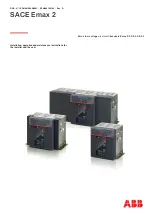
IB 6.2.11.1-2C
Page 16
ABB
Shunt Trip Device (See Figure 8).
a. Turn trip rod (2, Figure 8) down until circuit breaker
does not trip with plunger (3) held down.
b. Close circuit breaker.
c. Push plunger (3) down as far as possible and hold in
this position while turning up trip rod (2) until circuit
breaker just trips.
d. Turn rod (2) up approximately 2½ to 3 turns.
FIELD TESTING THE MPSC-2000 SOLID
STATE TRIP SYSTEM
There are two ways to evaluate the MPSC-2000 solid
state trip system: primary current injection through the
breaker main contacts; and secondary current injection
directly into the trip device. Either method will test the
trip device; primary injection has the advantage of
testing the current sensors and magnetic latch also.
The following is a procedure for performing this field
testing.
Notes:
1. Refer to time current curves TD-9651, TD-9652, and
TD-9653.
2. When checking calibration, disable the functions not
being tested, or set them at their highest threshold and
delay values.
It is especially important to disable
the Ground function when testing the other
elements to prevent false tripping.
5. Reference bulletin IB 6.1.2.8-1A for instructions on
setting the MPSC-2000.
6. These procedures are written for primary injection. If
the trip device is being tested by secondary current
injection, contact ABB for special instructions and/or
test equipment.
7. The term “Range Selection” is used herein for
consistency with previous MPS-type devices, and
refers to the value of the “Rating” setting of the device.
Like the previous MPS-type devices, the MPSC-2000 is
capable of operating at two basic ratings: one equal to
the maximum frame continuous current rating of the
breaker-mounted current sensors, and one equal to
half the frame rating. For example, on an 4000A
breaker with 4000A sensors, the MPSC-2000 rating
can be set to 4000A or 2000A. When the rating is
changed, other available settings are scaled
accordingly; thus the term “Range Selection”.
Instantaneous or Short Time Threshold Test
1. Either disable the trip elements not being tested, or
set them to their highest threshold value. Set the Long
Time Delay to its maximum setting. Set the Short Time
delay to its minimum setting for Short Time tests.
2. It is recommended that the Range Selection be set
to its lowest value to minimize the current required for
this test; however, it may be set to either available
value.
3. Set the threshold and delay of the trip element being
tested (again, it is recommended that a low value be
used).
4. Test for the actual threshold by increasing test
current until the breaker trips. It is important to
increase the current fast enough so that the breaker will
not be tripped by the Long Time element prior to
completion of the test.
5. The threshold tolerance is +/- 10% on all selector
Table 4 - MPSC-2000 Typical Delay Bands
Delay Times (sec.)
Trip Element
Min.
Int.
Max
Long Time
8-13
20-33
61-100
Short Time (DEF)
0.080-0.170
0.200-0.320
0.350-0.500
Short Time (IIT)
0.160-0.250
0.520-0.780
0.910-1.350
Ground Trip (IIT)
0.05-0.17
0.20-0.32
0.35-0.50
3. The circuit breaker
must be closed before
each test below.
4. Following each test,
check the MPSC-2000
event register to ensure
that the correct element
tripped the breaker,
especially if test results
appear to be incorrect.
WARNING WARNING WARNING WARNING
RISK TO PERSONNEL AND FIRE CAN RESULT IF
THE CIRCUIT BREAKER IS ENERGIZED WITHOUT
THE HARNESS PLUG AND SCREWS IN PLACE.
Содержание K-Line Plus KP-32
Страница 20: ...IB 6 2 11 1 2C Page 20 ABB NOTES ...
Страница 21: ...IB 6 2 11 1 2C Page 21 ABB NOTES ...





























